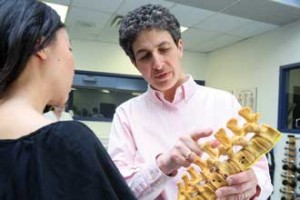
Sports Medicine Clinic isn’t just for athletes; musicians face similar injuries
By Cynthia Lee
Say “McGill Sports Clinic” and most people conjure images of hockey or football players rehabbing wonky knees. Chances are they wouldn’t imagine concert pianists icing sore wrists.
But treating the aches and pains of an athlete can be strikingly similar to caring for those of a musician.
“Musicians practice so much their body parts break down, just like those of an athlete,” said Lynn Bookalam, Head Therapist and Manager of the McGill Sports Clinic. “We treat musicians as athletes, and give them techniques and strategies to avoid injury and over-use syndrome.”
People with over-use syndrome suffer pain and loss of function in muscle groups and ligaments through excessive use. Repetition in music is one of the criteria for success, just like in sports. Think of playing exercises and scales as running laps or drills. Too much of either can lead to physical breakdown.
Five years ago, Prof. Douglas McNabney, Department of Performance, Schulich School of Music, and Dr. Pierre-Paul Tellier, Director, Student Affairs and Medical Education, Faculty of Medicine, became interested in musicians and health. The result is today’s excellent offering of health treatments and lecture-demonstrations designed to help keep musicians healthy at McGill.
The philosophy of the McGill Sports Clinic for all patients – musician and athlete alike – is a strong teamwork approach. “The Sports Clinic is here for the entire McGill community,” Bookalam said. The clinic is staffed with 15 therapists and 10 doctors.
As with any health issue, the road to recovery begins with getting a proper diagnosis. For musicians, an osteopath may work on a patient before he or she sees a masso-therapist, so that the injured muscle group can be loosened, optimizing treatment to follow.
If rugby, football and hockey players are the athletes most likely to be injured, violinists and saxophonists are music’s equivalents. Constant, small finger movements repeated over and over, combined with having to support the weight of an instrument, lead to problems with musicians’ necks, upper backs, elbows, wrists and hands. On top of treating these injuries, therapists at the clinic teach music students to focus more on warming up, stretching and on improving their posture.
“When a music student calls for specialized care, our staff is trained to respond,” Bookalam said. “Treating musicians and athletes are one and the same. I think they’re one of a kind, it’s only a different sport.”
